BUSN3050 - Examining Culture's Impact on IHRM in the US with Hofstede
VerifiedAdded on 2023/04/24
|14
|3915
|159
Essay
AI Summary
This essay examines the influence of culture on International Human Resource Management (IHRM), focusing on the United States and utilizing Hofstede's cultural dimensions model. It begins by defining IHRM and its increasing importance in a globalized world, highlighting the challenges multinational corporations face in managing human resources across diverse cultures. The study delves into how cultural values impact HRM practices, emphasizing the role of cultural competence in achieving a competitive advantage. Through the lens of Hofstede's model—Power Distance, Uncertainty Avoidance, Individualism/Collectivism, and Masculinity/Femininity—the essay analyzes how these dimensions affect management styles, employee participation, and organizational structures within US-based companies. It concludes by underscoring the necessity for IHRM professionals to understand and adapt to cultural nuances to effectively manage global workforces. Desklib provides access to this essay along with a wide range of study resources, including past papers and solved assignments, to support students in their academic endeavors.
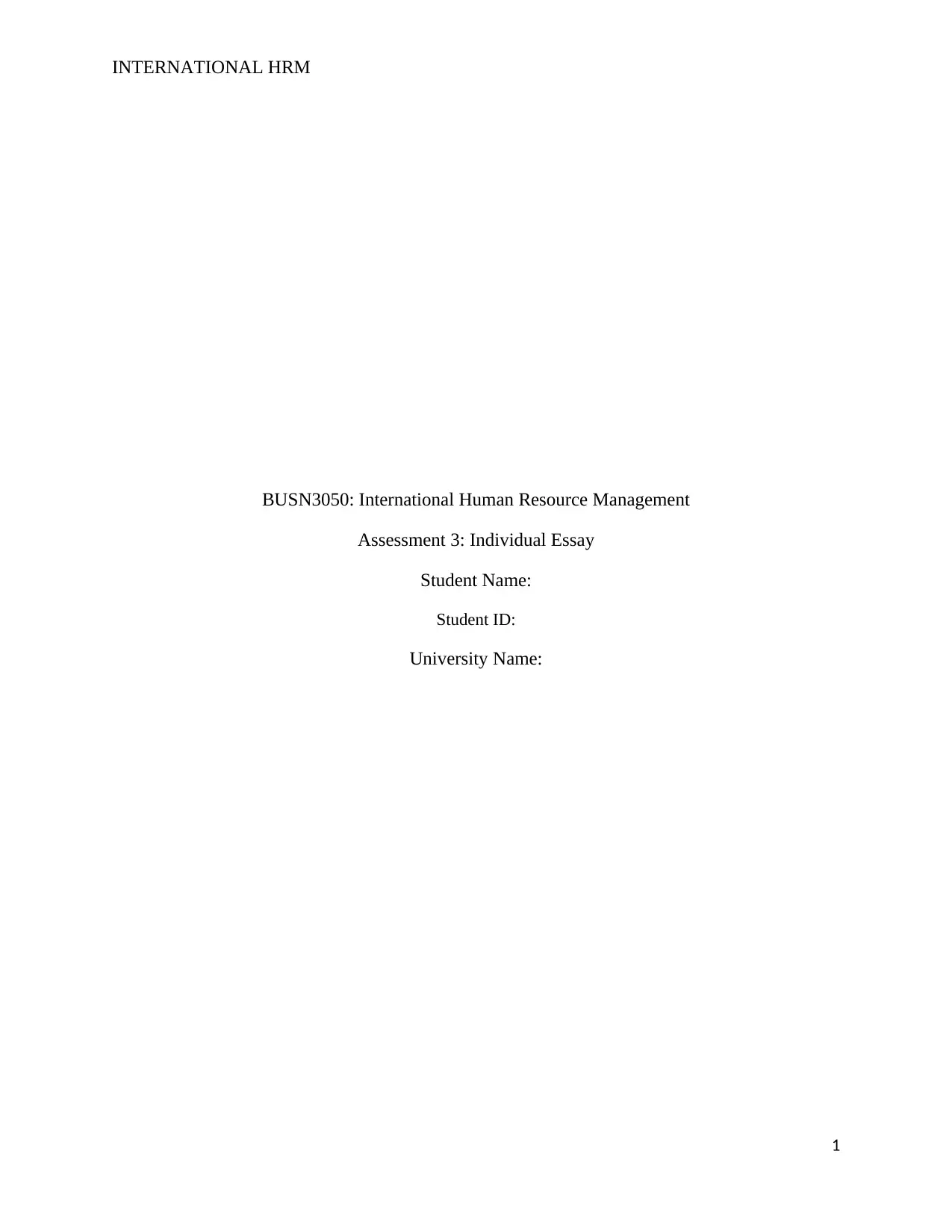
INTERNATIONAL HRM
BUSN3050: International Human Resource Management
Assessment 3: Individual Essay
Student Name:
Student ID:
University Name:
1
BUSN3050: International Human Resource Management
Assessment 3: Individual Essay
Student Name:
Student ID:
University Name:
1
Paraphrase This Document
Need a fresh take? Get an instant paraphrase of this document with our AI Paraphraser
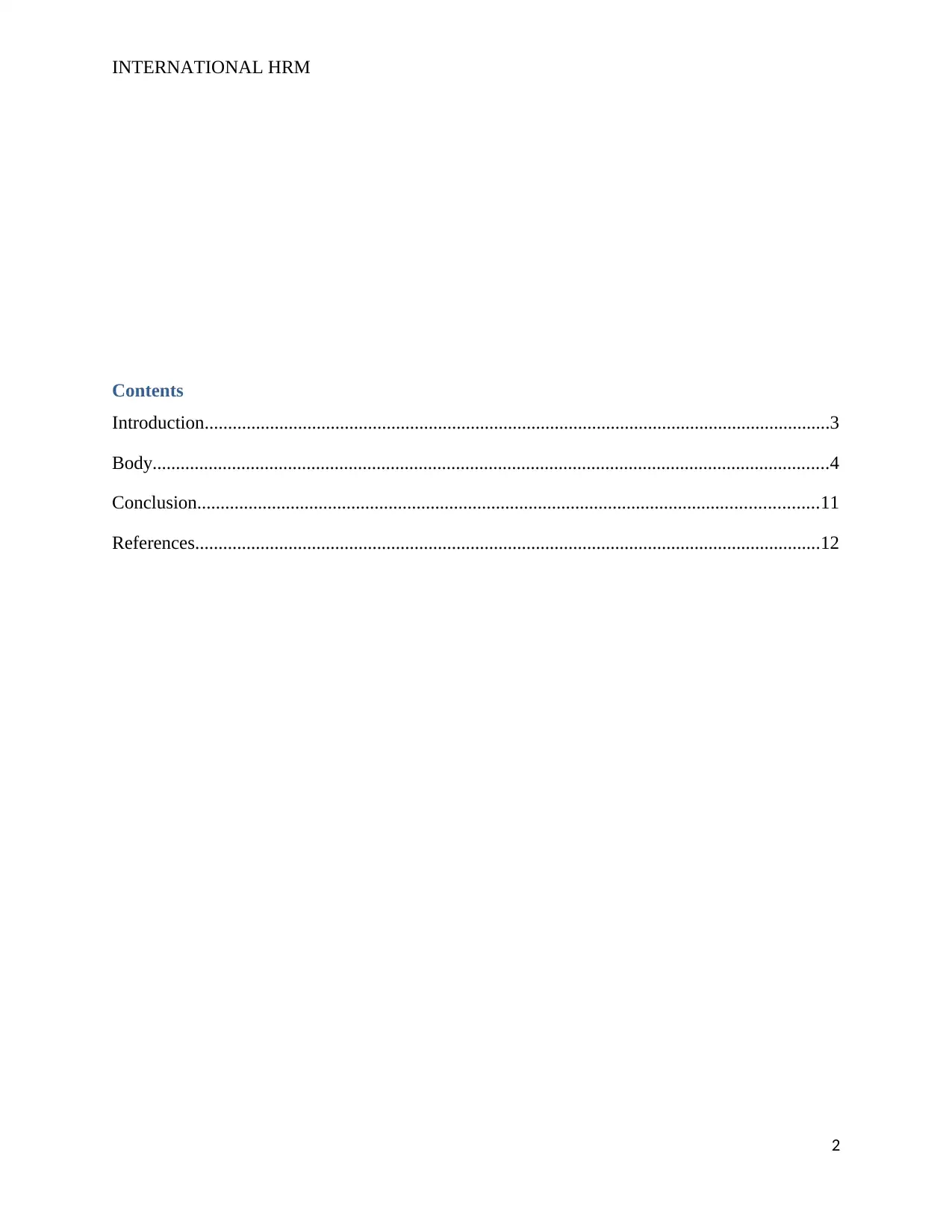
INTERNATIONAL HRM
Contents
Introduction......................................................................................................................................3
Body.................................................................................................................................................4
Conclusion.....................................................................................................................................11
References......................................................................................................................................12
2
Contents
Introduction......................................................................................................................................3
Body.................................................................................................................................................4
Conclusion.....................................................................................................................................11
References......................................................................................................................................12
2
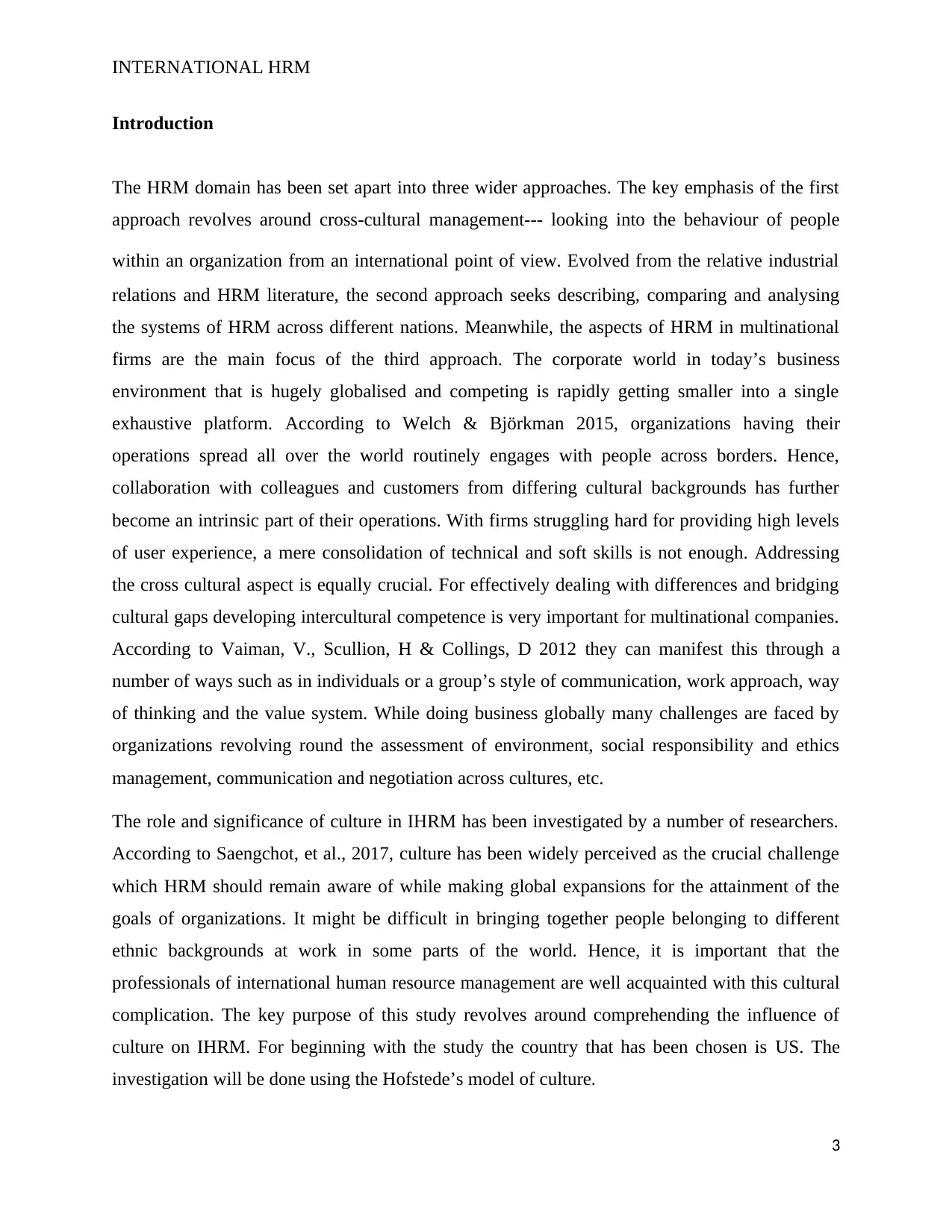
INTERNATIONAL HRM
Introduction
The HRM domain has been set apart into three wider approaches. The key emphasis of the first
approach revolves around cross-cultural management--- looking into the behaviour of people
within an organization from an international point of view. Evolved from the relative industrial
relations and HRM literature, the second approach seeks describing, comparing and analysing
the systems of HRM across different nations. Meanwhile, the aspects of HRM in multinational
firms are the main focus of the third approach. The corporate world in today’s business
environment that is hugely globalised and competing is rapidly getting smaller into a single
exhaustive platform. According to Welch & Björkman 2015, organizations having their
operations spread all over the world routinely engages with people across borders. Hence,
collaboration with colleagues and customers from differing cultural backgrounds has further
become an intrinsic part of their operations. With firms struggling hard for providing high levels
of user experience, a mere consolidation of technical and soft skills is not enough. Addressing
the cross cultural aspect is equally crucial. For effectively dealing with differences and bridging
cultural gaps developing intercultural competence is very important for multinational companies.
According to Vaiman, V., Scullion, H & Collings, D 2012 they can manifest this through a
number of ways such as in individuals or a group’s style of communication, work approach, way
of thinking and the value system. While doing business globally many challenges are faced by
organizations revolving round the assessment of environment, social responsibility and ethics
management, communication and negotiation across cultures, etc.
The role and significance of culture in IHRM has been investigated by a number of researchers.
According to Saengchot, et al., 2017, culture has been widely perceived as the crucial challenge
which HRM should remain aware of while making global expansions for the attainment of the
goals of organizations. It might be difficult in bringing together people belonging to different
ethnic backgrounds at work in some parts of the world. Hence, it is important that the
professionals of international human resource management are well acquainted with this cultural
complication. The key purpose of this study revolves around comprehending the influence of
culture on IHRM. For beginning with the study the country that has been chosen is US. The
investigation will be done using the Hofstede’s model of culture.
3
Introduction
The HRM domain has been set apart into three wider approaches. The key emphasis of the first
approach revolves around cross-cultural management--- looking into the behaviour of people
within an organization from an international point of view. Evolved from the relative industrial
relations and HRM literature, the second approach seeks describing, comparing and analysing
the systems of HRM across different nations. Meanwhile, the aspects of HRM in multinational
firms are the main focus of the third approach. The corporate world in today’s business
environment that is hugely globalised and competing is rapidly getting smaller into a single
exhaustive platform. According to Welch & Björkman 2015, organizations having their
operations spread all over the world routinely engages with people across borders. Hence,
collaboration with colleagues and customers from differing cultural backgrounds has further
become an intrinsic part of their operations. With firms struggling hard for providing high levels
of user experience, a mere consolidation of technical and soft skills is not enough. Addressing
the cross cultural aspect is equally crucial. For effectively dealing with differences and bridging
cultural gaps developing intercultural competence is very important for multinational companies.
According to Vaiman, V., Scullion, H & Collings, D 2012 they can manifest this through a
number of ways such as in individuals or a group’s style of communication, work approach, way
of thinking and the value system. While doing business globally many challenges are faced by
organizations revolving round the assessment of environment, social responsibility and ethics
management, communication and negotiation across cultures, etc.
The role and significance of culture in IHRM has been investigated by a number of researchers.
According to Saengchot, et al., 2017, culture has been widely perceived as the crucial challenge
which HRM should remain aware of while making global expansions for the attainment of the
goals of organizations. It might be difficult in bringing together people belonging to different
ethnic backgrounds at work in some parts of the world. Hence, it is important that the
professionals of international human resource management are well acquainted with this cultural
complication. The key purpose of this study revolves around comprehending the influence of
culture on IHRM. For beginning with the study the country that has been chosen is US. The
investigation will be done using the Hofstede’s model of culture.
3
⊘ This is a preview!⊘
Do you want full access?
Subscribe today to unlock all pages.

Trusted by 1+ million students worldwide
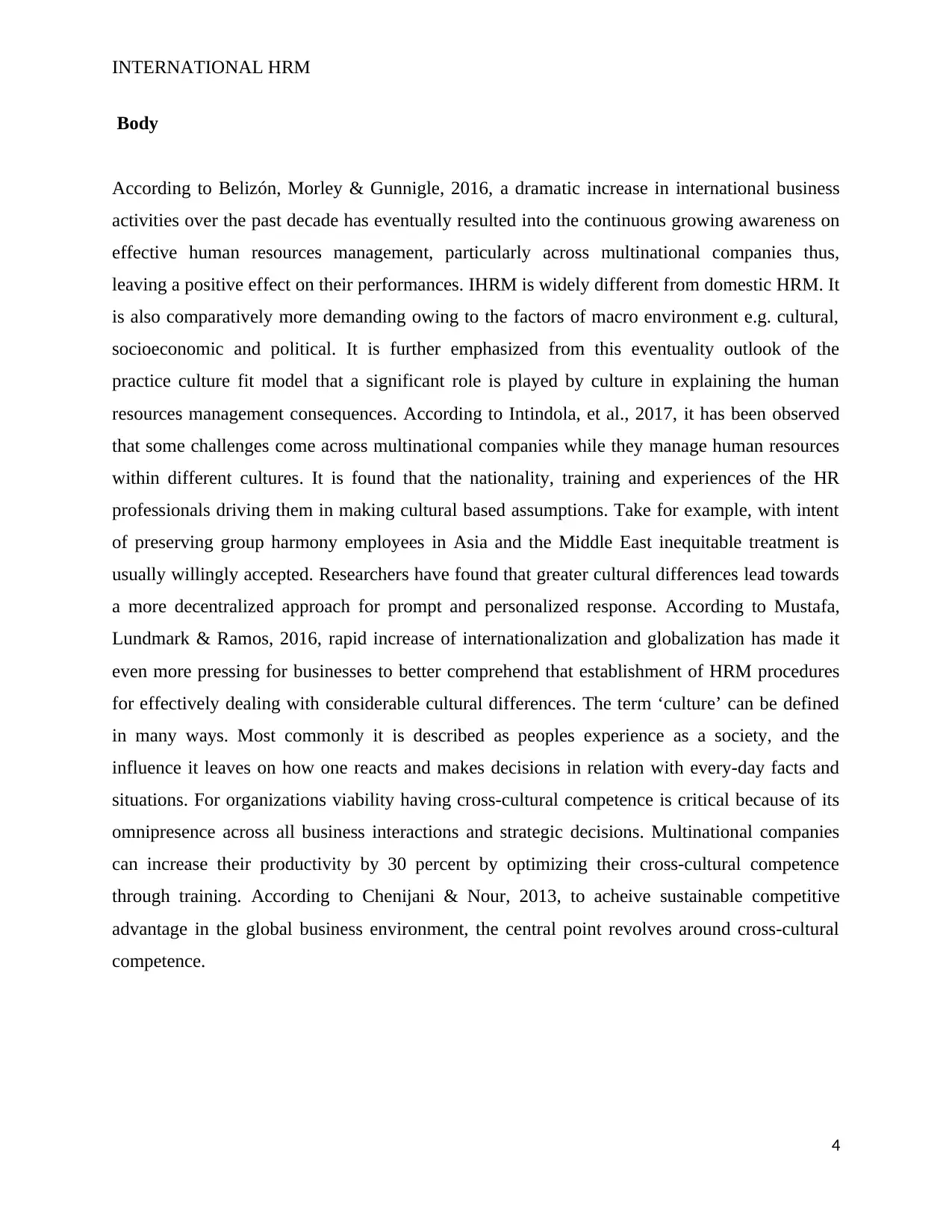
INTERNATIONAL HRM
Body
According to Belizón, Morley & Gunnigle, 2016, a dramatic increase in international business
activities over the past decade has eventually resulted into the continuous growing awareness on
effective human resources management, particularly across multinational companies thus,
leaving a positive effect on their performances. IHRM is widely different from domestic HRM. It
is also comparatively more demanding owing to the factors of macro environment e.g. cultural,
socioeconomic and political. It is further emphasized from this eventuality outlook of the
practice culture fit model that a significant role is played by culture in explaining the human
resources management consequences. According to Intindola, et al., 2017, it has been observed
that some challenges come across multinational companies while they manage human resources
within different cultures. It is found that the nationality, training and experiences of the HR
professionals driving them in making cultural based assumptions. Take for example, with intent
of preserving group harmony employees in Asia and the Middle East inequitable treatment is
usually willingly accepted. Researchers have found that greater cultural differences lead towards
a more decentralized approach for prompt and personalized response. According to Mustafa,
Lundmark & Ramos, 2016, rapid increase of internationalization and globalization has made it
even more pressing for businesses to better comprehend that establishment of HRM procedures
for effectively dealing with considerable cultural differences. The term ‘culture’ can be defined
in many ways. Most commonly it is described as peoples experience as a society, and the
influence it leaves on how one reacts and makes decisions in relation with every-day facts and
situations. For organizations viability having cross-cultural competence is critical because of its
omnipresence across all business interactions and strategic decisions. Multinational companies
can increase their productivity by 30 percent by optimizing their cross-cultural competence
through training. According to Chenijani & Nour, 2013, to acheive sustainable competitive
advantage in the global business environment, the central point revolves around cross-cultural
competence.
4
Body
According to Belizón, Morley & Gunnigle, 2016, a dramatic increase in international business
activities over the past decade has eventually resulted into the continuous growing awareness on
effective human resources management, particularly across multinational companies thus,
leaving a positive effect on their performances. IHRM is widely different from domestic HRM. It
is also comparatively more demanding owing to the factors of macro environment e.g. cultural,
socioeconomic and political. It is further emphasized from this eventuality outlook of the
practice culture fit model that a significant role is played by culture in explaining the human
resources management consequences. According to Intindola, et al., 2017, it has been observed
that some challenges come across multinational companies while they manage human resources
within different cultures. It is found that the nationality, training and experiences of the HR
professionals driving them in making cultural based assumptions. Take for example, with intent
of preserving group harmony employees in Asia and the Middle East inequitable treatment is
usually willingly accepted. Researchers have found that greater cultural differences lead towards
a more decentralized approach for prompt and personalized response. According to Mustafa,
Lundmark & Ramos, 2016, rapid increase of internationalization and globalization has made it
even more pressing for businesses to better comprehend that establishment of HRM procedures
for effectively dealing with considerable cultural differences. The term ‘culture’ can be defined
in many ways. Most commonly it is described as peoples experience as a society, and the
influence it leaves on how one reacts and makes decisions in relation with every-day facts and
situations. For organizations viability having cross-cultural competence is critical because of its
omnipresence across all business interactions and strategic decisions. Multinational companies
can increase their productivity by 30 percent by optimizing their cross-cultural competence
through training. According to Chenijani & Nour, 2013, to acheive sustainable competitive
advantage in the global business environment, the central point revolves around cross-cultural
competence.
4
Paraphrase This Document
Need a fresh take? Get an instant paraphrase of this document with our AI Paraphraser
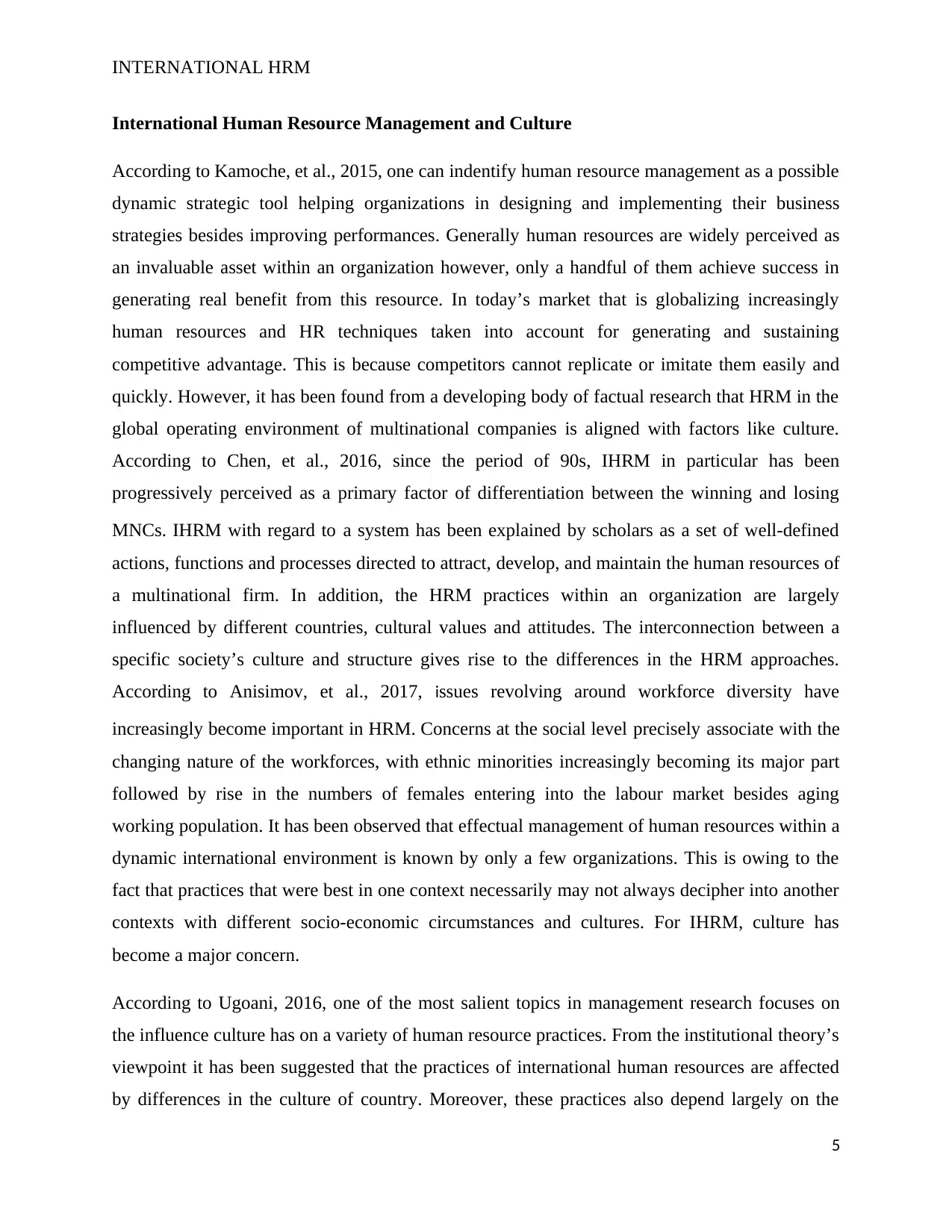
INTERNATIONAL HRM
International Human Resource Management and Culture
According to Kamoche, et al., 2015, one can indentify human resource management as a possible
dynamic strategic tool helping organizations in designing and implementing their business
strategies besides improving performances. Generally human resources are widely perceived as
an invaluable asset within an organization however, only a handful of them achieve success in
generating real benefit from this resource. In today’s market that is globalizing increasingly
human resources and HR techniques taken into account for generating and sustaining
competitive advantage. This is because competitors cannot replicate or imitate them easily and
quickly. However, it has been found from a developing body of factual research that HRM in the
global operating environment of multinational companies is aligned with factors like culture.
According to Chen, et al., 2016, since the period of 90s, IHRM in particular has been
progressively perceived as a primary factor of differentiation between the winning and losing
MNCs. IHRM with regard to a system has been explained by scholars as a set of well-defined
actions, functions and processes directed to attract, develop, and maintain the human resources of
a multinational firm. In addition, the HRM practices within an organization are largely
influenced by different countries, cultural values and attitudes. The interconnection between a
specific society’s culture and structure gives rise to the differences in the HRM approaches.
According to Anisimov, et al., 2017, issues revolving around workforce diversity have
increasingly become important in HRM. Concerns at the social level precisely associate with the
changing nature of the workforces, with ethnic minorities increasingly becoming its major part
followed by rise in the numbers of females entering into the labour market besides aging
working population. It has been observed that effectual management of human resources within a
dynamic international environment is known by only a few organizations. This is owing to the
fact that practices that were best in one context necessarily may not always decipher into another
contexts with different socio-economic circumstances and cultures. For IHRM, culture has
become a major concern.
According to Ugoani, 2016, one of the most salient topics in management research focuses on
the influence culture has on a variety of human resource practices. From the institutional theory’s
viewpoint it has been suggested that the practices of international human resources are affected
by differences in the culture of country. Moreover, these practices also depend largely on the
5
International Human Resource Management and Culture
According to Kamoche, et al., 2015, one can indentify human resource management as a possible
dynamic strategic tool helping organizations in designing and implementing their business
strategies besides improving performances. Generally human resources are widely perceived as
an invaluable asset within an organization however, only a handful of them achieve success in
generating real benefit from this resource. In today’s market that is globalizing increasingly
human resources and HR techniques taken into account for generating and sustaining
competitive advantage. This is because competitors cannot replicate or imitate them easily and
quickly. However, it has been found from a developing body of factual research that HRM in the
global operating environment of multinational companies is aligned with factors like culture.
According to Chen, et al., 2016, since the period of 90s, IHRM in particular has been
progressively perceived as a primary factor of differentiation between the winning and losing
MNCs. IHRM with regard to a system has been explained by scholars as a set of well-defined
actions, functions and processes directed to attract, develop, and maintain the human resources of
a multinational firm. In addition, the HRM practices within an organization are largely
influenced by different countries, cultural values and attitudes. The interconnection between a
specific society’s culture and structure gives rise to the differences in the HRM approaches.
According to Anisimov, et al., 2017, issues revolving around workforce diversity have
increasingly become important in HRM. Concerns at the social level precisely associate with the
changing nature of the workforces, with ethnic minorities increasingly becoming its major part
followed by rise in the numbers of females entering into the labour market besides aging
working population. It has been observed that effectual management of human resources within a
dynamic international environment is known by only a few organizations. This is owing to the
fact that practices that were best in one context necessarily may not always decipher into another
contexts with different socio-economic circumstances and cultures. For IHRM, culture has
become a major concern.
According to Ugoani, 2016, one of the most salient topics in management research focuses on
the influence culture has on a variety of human resource practices. From the institutional theory’s
viewpoint it has been suggested that the practices of international human resources are affected
by differences in the culture of country. Moreover, these practices also depend largely on the
5
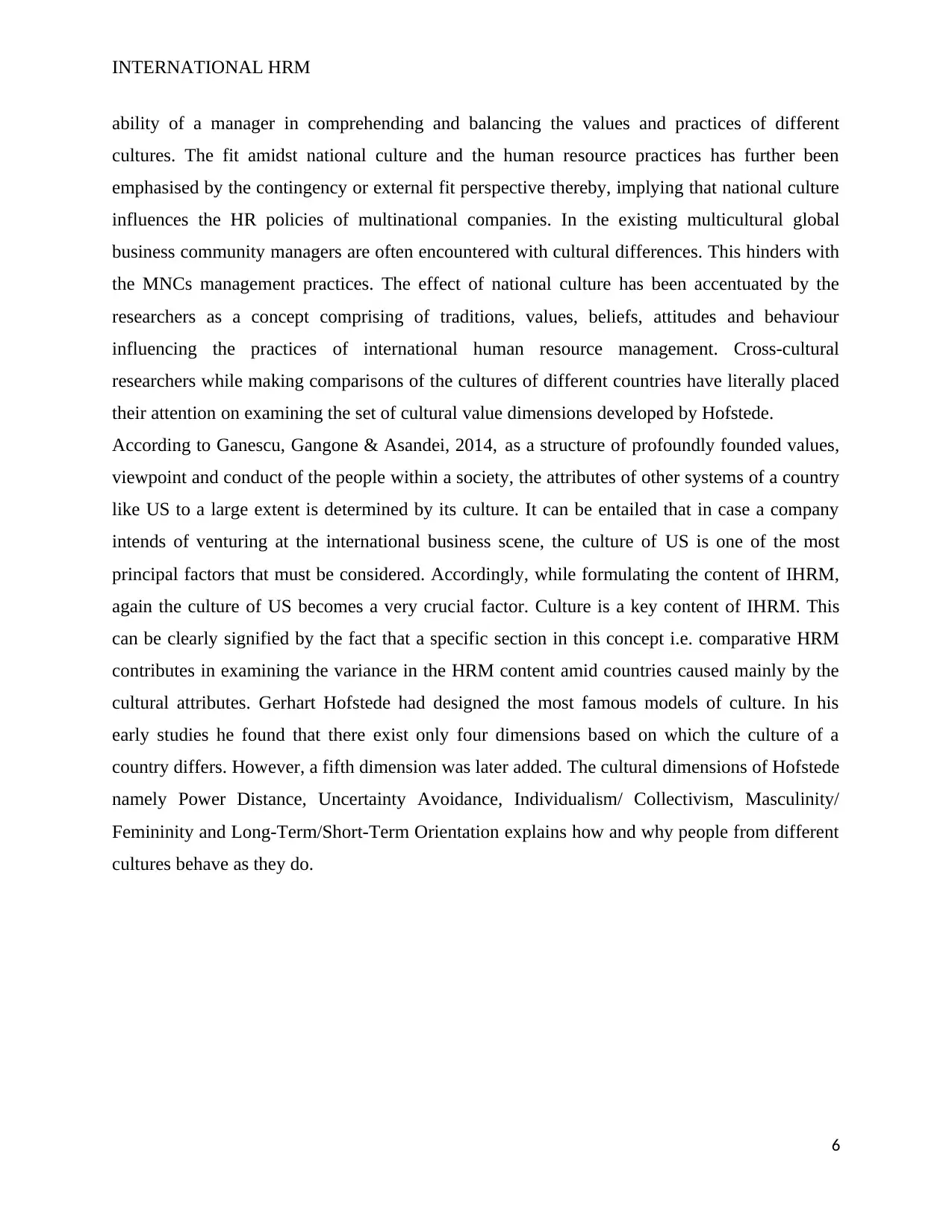
INTERNATIONAL HRM
ability of a manager in comprehending and balancing the values and practices of different
cultures. The fit amidst national culture and the human resource practices has further been
emphasised by the contingency or external fit perspective thereby, implying that national culture
influences the HR policies of multinational companies. In the existing multicultural global
business community managers are often encountered with cultural differences. This hinders with
the MNCs management practices. The effect of national culture has been accentuated by the
researchers as a concept comprising of traditions, values, beliefs, attitudes and behaviour
influencing the practices of international human resource management. Cross-cultural
researchers while making comparisons of the cultures of different countries have literally placed
their attention on examining the set of cultural value dimensions developed by Hofstede.
According to Ganescu, Gangone & Asandei, 2014, as a structure of profoundly founded values,
viewpoint and conduct of the people within a society, the attributes of other systems of a country
like US to a large extent is determined by its culture. It can be entailed that in case a company
intends of venturing at the international business scene, the culture of US is one of the most
principal factors that must be considered. Accordingly, while formulating the content of IHRM,
again the culture of US becomes a very crucial factor. Culture is a key content of IHRM. This
can be clearly signified by the fact that a specific section in this concept i.e. comparative HRM
contributes in examining the variance in the HRM content amid countries caused mainly by the
cultural attributes. Gerhart Hofstede had designed the most famous models of culture. In his
early studies he found that there exist only four dimensions based on which the culture of a
country differs. However, a fifth dimension was later added. The cultural dimensions of Hofstede
namely Power Distance, Uncertainty Avoidance, Individualism/ Collectivism, Masculinity/
Femininity and Long-Term/Short-Term Orientation explains how and why people from different
cultures behave as they do.
6
ability of a manager in comprehending and balancing the values and practices of different
cultures. The fit amidst national culture and the human resource practices has further been
emphasised by the contingency or external fit perspective thereby, implying that national culture
influences the HR policies of multinational companies. In the existing multicultural global
business community managers are often encountered with cultural differences. This hinders with
the MNCs management practices. The effect of national culture has been accentuated by the
researchers as a concept comprising of traditions, values, beliefs, attitudes and behaviour
influencing the practices of international human resource management. Cross-cultural
researchers while making comparisons of the cultures of different countries have literally placed
their attention on examining the set of cultural value dimensions developed by Hofstede.
According to Ganescu, Gangone & Asandei, 2014, as a structure of profoundly founded values,
viewpoint and conduct of the people within a society, the attributes of other systems of a country
like US to a large extent is determined by its culture. It can be entailed that in case a company
intends of venturing at the international business scene, the culture of US is one of the most
principal factors that must be considered. Accordingly, while formulating the content of IHRM,
again the culture of US becomes a very crucial factor. Culture is a key content of IHRM. This
can be clearly signified by the fact that a specific section in this concept i.e. comparative HRM
contributes in examining the variance in the HRM content amid countries caused mainly by the
cultural attributes. Gerhart Hofstede had designed the most famous models of culture. In his
early studies he found that there exist only four dimensions based on which the culture of a
country differs. However, a fifth dimension was later added. The cultural dimensions of Hofstede
namely Power Distance, Uncertainty Avoidance, Individualism/ Collectivism, Masculinity/
Femininity and Long-Term/Short-Term Orientation explains how and why people from different
cultures behave as they do.
6
⊘ This is a preview!⊘
Do you want full access?
Subscribe today to unlock all pages.

Trusted by 1+ million students worldwide
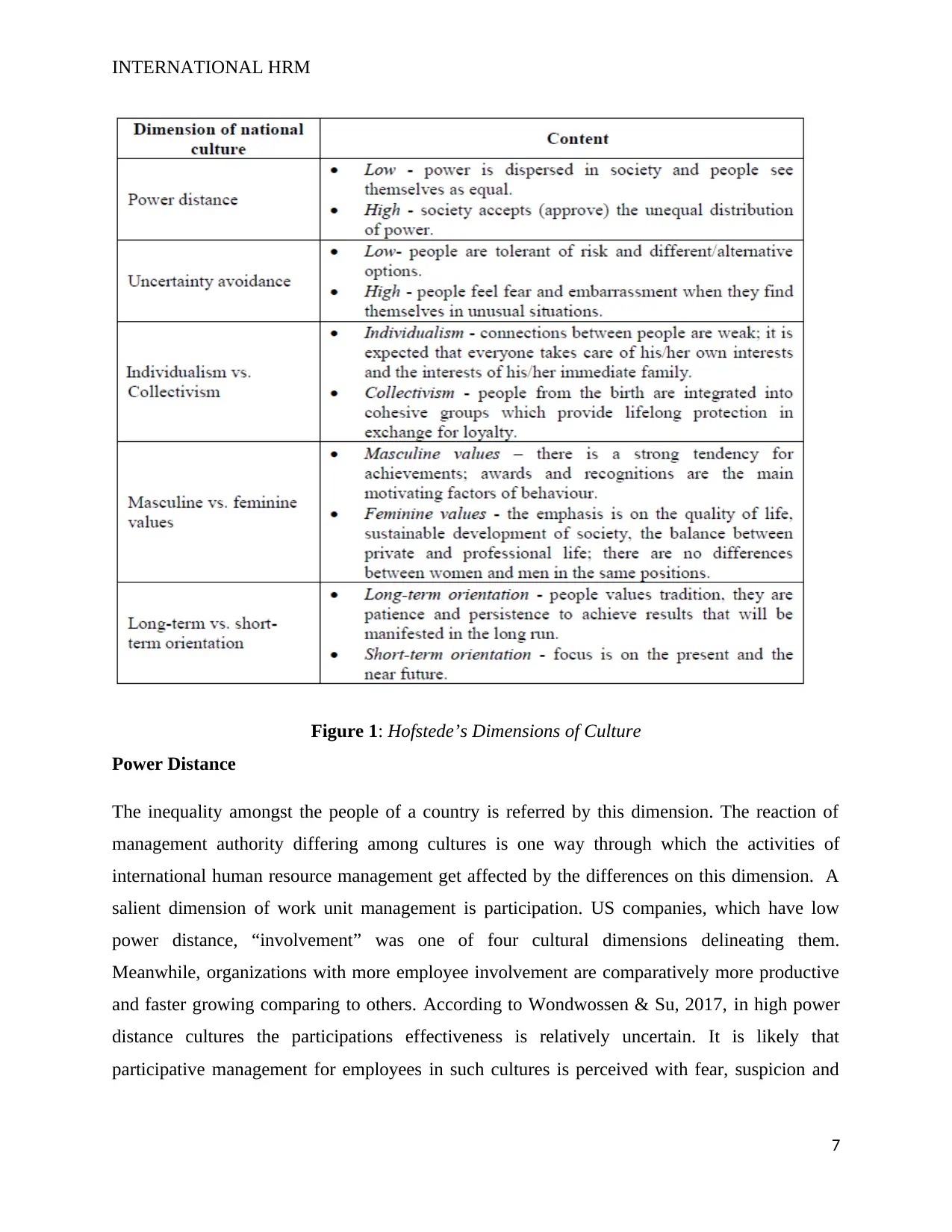
INTERNATIONAL HRM
Figure 1: Hofstede’s Dimensions of Culture
Power Distance
The inequality amongst the people of a country is referred by this dimension. The reaction of
management authority differing among cultures is one way through which the activities of
international human resource management get affected by the differences on this dimension. A
salient dimension of work unit management is participation. US companies, which have low
power distance, “involvement” was one of four cultural dimensions delineating them.
Meanwhile, organizations with more employee involvement are comparatively more productive
and faster growing comparing to others. According to Wondwossen & Su, 2017, in high power
distance cultures the participations effectiveness is relatively uncertain. It is likely that
participative management for employees in such cultures is perceived with fear, suspicion and
7
Figure 1: Hofstede’s Dimensions of Culture
Power Distance
The inequality amongst the people of a country is referred by this dimension. The reaction of
management authority differing among cultures is one way through which the activities of
international human resource management get affected by the differences on this dimension. A
salient dimension of work unit management is participation. US companies, which have low
power distance, “involvement” was one of four cultural dimensions delineating them.
Meanwhile, organizations with more employee involvement are comparatively more productive
and faster growing comparing to others. According to Wondwossen & Su, 2017, in high power
distance cultures the participations effectiveness is relatively uncertain. It is likely that
participative management for employees in such cultures is perceived with fear, suspicion and
7
Paraphrase This Document
Need a fresh take? Get an instant paraphrase of this document with our AI Paraphraser
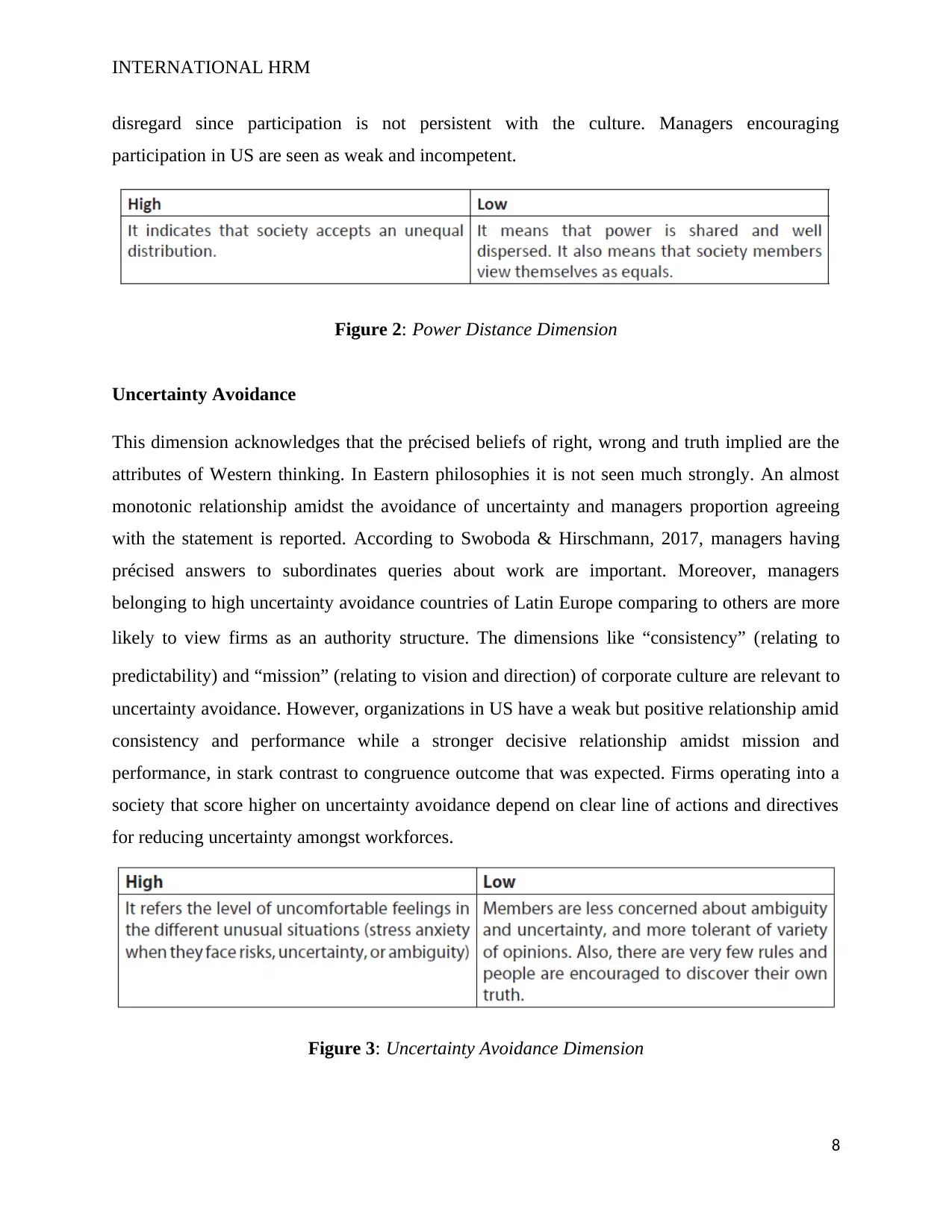
INTERNATIONAL HRM
disregard since participation is not persistent with the culture. Managers encouraging
participation in US are seen as weak and incompetent.
Figure 2: Power Distance Dimension
Uncertainty Avoidance
This dimension acknowledges that the précised beliefs of right, wrong and truth implied are the
attributes of Western thinking. In Eastern philosophies it is not seen much strongly. An almost
monotonic relationship amidst the avoidance of uncertainty and managers proportion agreeing
with the statement is reported. According to Swoboda & Hirschmann, 2017, managers having
précised answers to subordinates queries about work are important. Moreover, managers
belonging to high uncertainty avoidance countries of Latin Europe comparing to others are more
likely to view firms as an authority structure. The dimensions like “consistency” (relating to
predictability) and “mission” (relating to vision and direction) of corporate culture are relevant to
uncertainty avoidance. However, organizations in US have a weak but positive relationship amid
consistency and performance while a stronger decisive relationship amidst mission and
performance, in stark contrast to congruence outcome that was expected. Firms operating into a
society that score higher on uncertainty avoidance depend on clear line of actions and directives
for reducing uncertainty amongst workforces.
Figure 3: Uncertainty Avoidance Dimension
8
disregard since participation is not persistent with the culture. Managers encouraging
participation in US are seen as weak and incompetent.
Figure 2: Power Distance Dimension
Uncertainty Avoidance
This dimension acknowledges that the précised beliefs of right, wrong and truth implied are the
attributes of Western thinking. In Eastern philosophies it is not seen much strongly. An almost
monotonic relationship amidst the avoidance of uncertainty and managers proportion agreeing
with the statement is reported. According to Swoboda & Hirschmann, 2017, managers having
précised answers to subordinates queries about work are important. Moreover, managers
belonging to high uncertainty avoidance countries of Latin Europe comparing to others are more
likely to view firms as an authority structure. The dimensions like “consistency” (relating to
predictability) and “mission” (relating to vision and direction) of corporate culture are relevant to
uncertainty avoidance. However, organizations in US have a weak but positive relationship amid
consistency and performance while a stronger decisive relationship amidst mission and
performance, in stark contrast to congruence outcome that was expected. Firms operating into a
society that score higher on uncertainty avoidance depend on clear line of actions and directives
for reducing uncertainty amongst workforces.
Figure 3: Uncertainty Avoidance Dimension
8
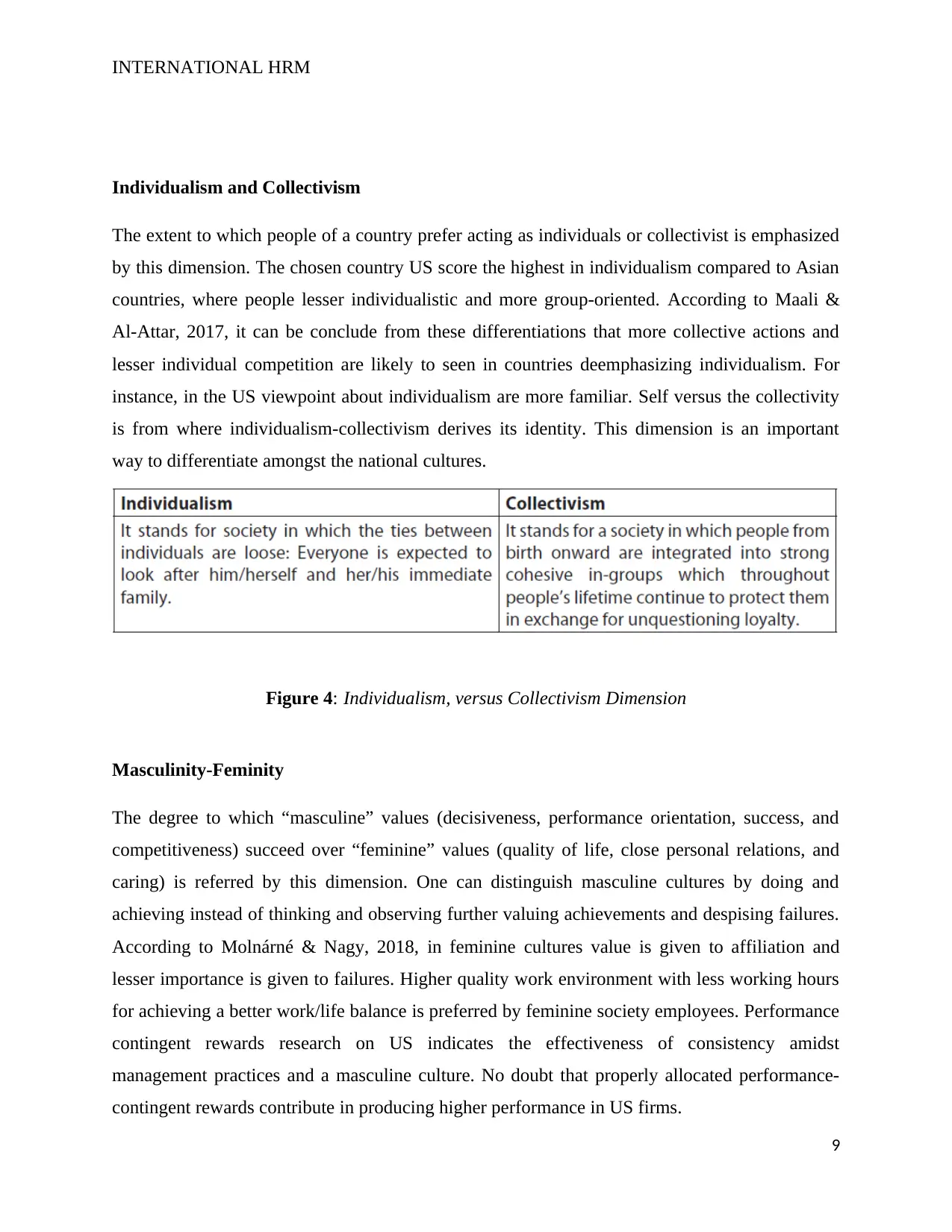
INTERNATIONAL HRM
Individualism and Collectivism
The extent to which people of a country prefer acting as individuals or collectivist is emphasized
by this dimension. The chosen country US score the highest in individualism compared to Asian
countries, where people lesser individualistic and more group-oriented. According to Maali &
Al-Attar, 2017, it can be conclude from these differentiations that more collective actions and
lesser individual competition are likely to seen in countries deemphasizing individualism. For
instance, in the US viewpoint about individualism are more familiar. Self versus the collectivity
is from where individualism-collectivism derives its identity. This dimension is an important
way to differentiate amongst the national cultures.
Figure 4: Individualism, versus Collectivism Dimension
Masculinity-Feminity
The degree to which “masculine” values (decisiveness, performance orientation, success, and
competitiveness) succeed over “feminine” values (quality of life, close personal relations, and
caring) is referred by this dimension. One can distinguish masculine cultures by doing and
achieving instead of thinking and observing further valuing achievements and despising failures.
According to Molnárné & Nagy, 2018, in feminine cultures value is given to affiliation and
lesser importance is given to failures. Higher quality work environment with less working hours
for achieving a better work/life balance is preferred by feminine society employees. Performance
contingent rewards research on US indicates the effectiveness of consistency amidst
management practices and a masculine culture. No doubt that properly allocated performance-
contingent rewards contribute in producing higher performance in US firms.
9
Individualism and Collectivism
The extent to which people of a country prefer acting as individuals or collectivist is emphasized
by this dimension. The chosen country US score the highest in individualism compared to Asian
countries, where people lesser individualistic and more group-oriented. According to Maali &
Al-Attar, 2017, it can be conclude from these differentiations that more collective actions and
lesser individual competition are likely to seen in countries deemphasizing individualism. For
instance, in the US viewpoint about individualism are more familiar. Self versus the collectivity
is from where individualism-collectivism derives its identity. This dimension is an important
way to differentiate amongst the national cultures.
Figure 4: Individualism, versus Collectivism Dimension
Masculinity-Feminity
The degree to which “masculine” values (decisiveness, performance orientation, success, and
competitiveness) succeed over “feminine” values (quality of life, close personal relations, and
caring) is referred by this dimension. One can distinguish masculine cultures by doing and
achieving instead of thinking and observing further valuing achievements and despising failures.
According to Molnárné & Nagy, 2018, in feminine cultures value is given to affiliation and
lesser importance is given to failures. Higher quality work environment with less working hours
for achieving a better work/life balance is preferred by feminine society employees. Performance
contingent rewards research on US indicates the effectiveness of consistency amidst
management practices and a masculine culture. No doubt that properly allocated performance-
contingent rewards contribute in producing higher performance in US firms.
9
⊘ This is a preview!⊘
Do you want full access?
Subscribe today to unlock all pages.

Trusted by 1+ million students worldwide
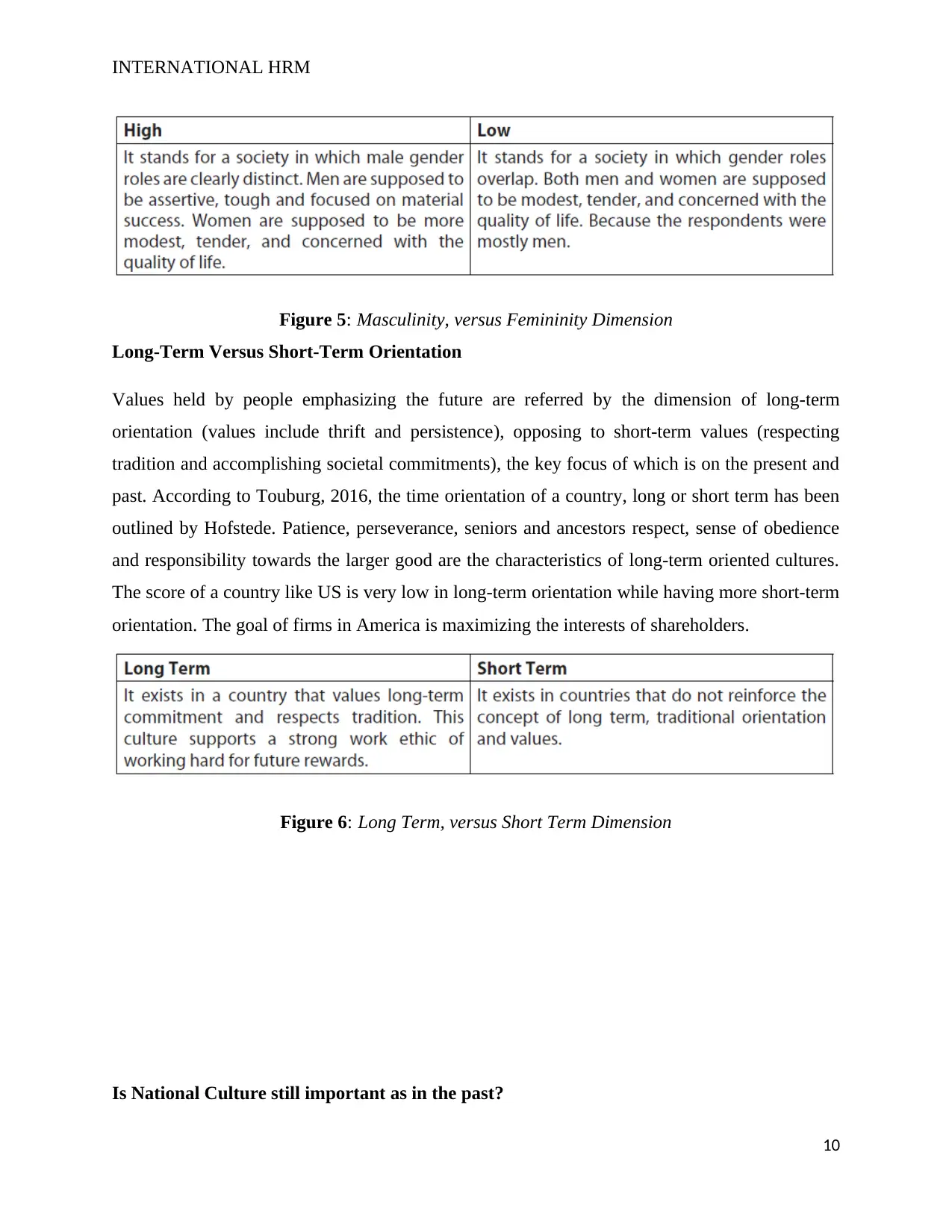
INTERNATIONAL HRM
Figure 5: Masculinity, versus Femininity Dimension
Long-Term Versus Short-Term Orientation
Values held by people emphasizing the future are referred by the dimension of long-term
orientation (values include thrift and persistence), opposing to short-term values (respecting
tradition and accomplishing societal commitments), the key focus of which is on the present and
past. According to Touburg, 2016, the time orientation of a country, long or short term has been
outlined by Hofstede. Patience, perseverance, seniors and ancestors respect, sense of obedience
and responsibility towards the larger good are the characteristics of long-term oriented cultures.
The score of a country like US is very low in long-term orientation while having more short-term
orientation. The goal of firms in America is maximizing the interests of shareholders.
Figure 6: Long Term, versus Short Term Dimension
Is National Culture still important as in the past?
10
Figure 5: Masculinity, versus Femininity Dimension
Long-Term Versus Short-Term Orientation
Values held by people emphasizing the future are referred by the dimension of long-term
orientation (values include thrift and persistence), opposing to short-term values (respecting
tradition and accomplishing societal commitments), the key focus of which is on the present and
past. According to Touburg, 2016, the time orientation of a country, long or short term has been
outlined by Hofstede. Patience, perseverance, seniors and ancestors respect, sense of obedience
and responsibility towards the larger good are the characteristics of long-term oriented cultures.
The score of a country like US is very low in long-term orientation while having more short-term
orientation. The goal of firms in America is maximizing the interests of shareholders.
Figure 6: Long Term, versus Short Term Dimension
Is National Culture still important as in the past?
10
Paraphrase This Document
Need a fresh take? Get an instant paraphrase of this document with our AI Paraphraser
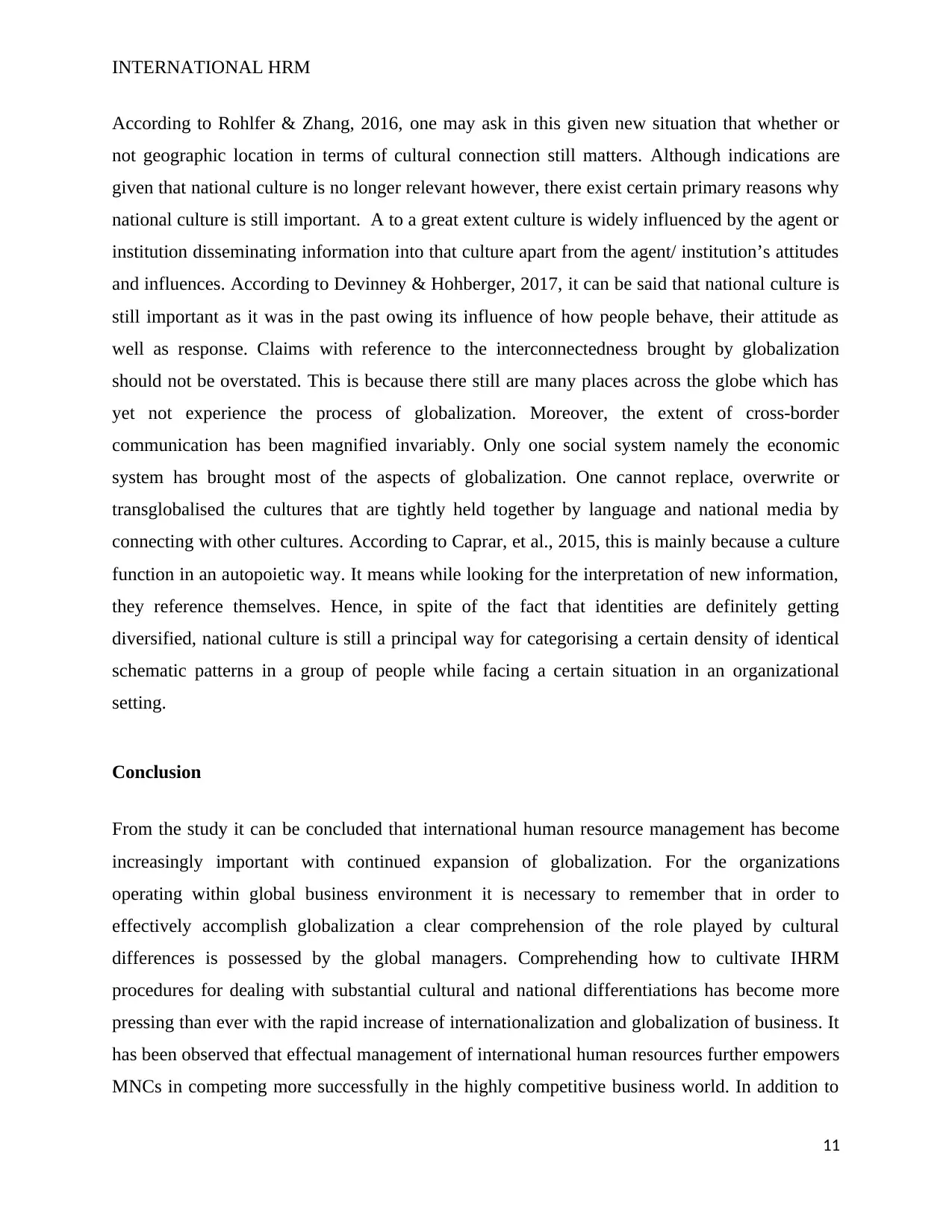
INTERNATIONAL HRM
According to Rohlfer & Zhang, 2016, one may ask in this given new situation that whether or
not geographic location in terms of cultural connection still matters. Although indications are
given that national culture is no longer relevant however, there exist certain primary reasons why
national culture is still important. A to a great extent culture is widely influenced by the agent or
institution disseminating information into that culture apart from the agent/ institution’s attitudes
and influences. According to Devinney & Hohberger, 2017, it can be said that national culture is
still important as it was in the past owing its influence of how people behave, their attitude as
well as response. Claims with reference to the interconnectedness brought by globalization
should not be overstated. This is because there still are many places across the globe which has
yet not experience the process of globalization. Moreover, the extent of cross-border
communication has been magnified invariably. Only one social system namely the economic
system has brought most of the aspects of globalization. One cannot replace, overwrite or
transglobalised the cultures that are tightly held together by language and national media by
connecting with other cultures. According to Caprar, et al., 2015, this is mainly because a culture
function in an autopoietic way. It means while looking for the interpretation of new information,
they reference themselves. Hence, in spite of the fact that identities are definitely getting
diversified, national culture is still a principal way for categorising a certain density of identical
schematic patterns in a group of people while facing a certain situation in an organizational
setting.
Conclusion
From the study it can be concluded that international human resource management has become
increasingly important with continued expansion of globalization. For the organizations
operating within global business environment it is necessary to remember that in order to
effectively accomplish globalization a clear comprehension of the role played by cultural
differences is possessed by the global managers. Comprehending how to cultivate IHRM
procedures for dealing with substantial cultural and national differentiations has become more
pressing than ever with the rapid increase of internationalization and globalization of business. It
has been observed that effectual management of international human resources further empowers
MNCs in competing more successfully in the highly competitive business world. In addition to
11
According to Rohlfer & Zhang, 2016, one may ask in this given new situation that whether or
not geographic location in terms of cultural connection still matters. Although indications are
given that national culture is no longer relevant however, there exist certain primary reasons why
national culture is still important. A to a great extent culture is widely influenced by the agent or
institution disseminating information into that culture apart from the agent/ institution’s attitudes
and influences. According to Devinney & Hohberger, 2017, it can be said that national culture is
still important as it was in the past owing its influence of how people behave, their attitude as
well as response. Claims with reference to the interconnectedness brought by globalization
should not be overstated. This is because there still are many places across the globe which has
yet not experience the process of globalization. Moreover, the extent of cross-border
communication has been magnified invariably. Only one social system namely the economic
system has brought most of the aspects of globalization. One cannot replace, overwrite or
transglobalised the cultures that are tightly held together by language and national media by
connecting with other cultures. According to Caprar, et al., 2015, this is mainly because a culture
function in an autopoietic way. It means while looking for the interpretation of new information,
they reference themselves. Hence, in spite of the fact that identities are definitely getting
diversified, national culture is still a principal way for categorising a certain density of identical
schematic patterns in a group of people while facing a certain situation in an organizational
setting.
Conclusion
From the study it can be concluded that international human resource management has become
increasingly important with continued expansion of globalization. For the organizations
operating within global business environment it is necessary to remember that in order to
effectively accomplish globalization a clear comprehension of the role played by cultural
differences is possessed by the global managers. Comprehending how to cultivate IHRM
procedures for dealing with substantial cultural and national differentiations has become more
pressing than ever with the rapid increase of internationalization and globalization of business. It
has been observed that effectual management of international human resources further empowers
MNCs in competing more successfully in the highly competitive business world. In addition to
11
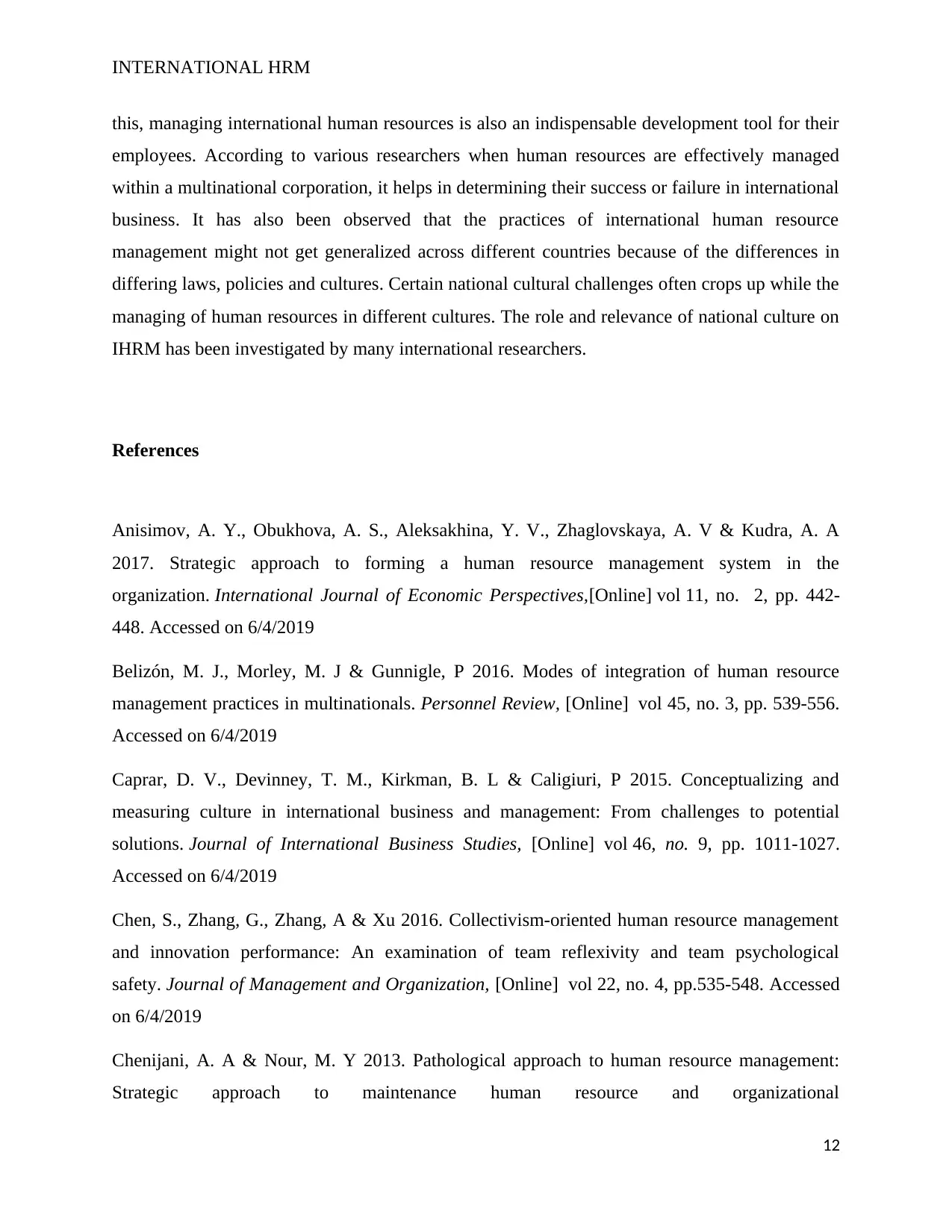
INTERNATIONAL HRM
this, managing international human resources is also an indispensable development tool for their
employees. According to various researchers when human resources are effectively managed
within a multinational corporation, it helps in determining their success or failure in international
business. It has also been observed that the practices of international human resource
management might not get generalized across different countries because of the differences in
differing laws, policies and cultures. Certain national cultural challenges often crops up while the
managing of human resources in different cultures. The role and relevance of national culture on
IHRM has been investigated by many international researchers.
References
Anisimov, A. Y., Obukhova, A. S., Aleksakhina, Y. V., Zhaglovskaya, A. V & Kudra, A. A
2017. Strategic approach to forming a human resource management system in the
organization. International Journal of Economic Perspectives,[Online] vol 11, no. 2, pp. 442-
448. Accessed on 6/4/2019
Belizón, M. J., Morley, M. J & Gunnigle, P 2016. Modes of integration of human resource
management practices in multinationals. Personnel Review, [Online] vol 45, no. 3, pp. 539-556.
Accessed on 6/4/2019
Caprar, D. V., Devinney, T. M., Kirkman, B. L & Caligiuri, P 2015. Conceptualizing and
measuring culture in international business and management: From challenges to potential
solutions. Journal of International Business Studies, [Online] vol 46, no. 9, pp. 1011-1027.
Accessed on 6/4/2019
Chen, S., Zhang, G., Zhang, A & Xu 2016. Collectivism-oriented human resource management
and innovation performance: An examination of team reflexivity and team psychological
safety. Journal of Management and Organization, [Online] vol 22, no. 4, pp.535-548. Accessed
on 6/4/2019
Chenijani, A. A & Nour, M. Y 2013. Pathological approach to human resource management:
Strategic approach to maintenance human resource and organizational
12
this, managing international human resources is also an indispensable development tool for their
employees. According to various researchers when human resources are effectively managed
within a multinational corporation, it helps in determining their success or failure in international
business. It has also been observed that the practices of international human resource
management might not get generalized across different countries because of the differences in
differing laws, policies and cultures. Certain national cultural challenges often crops up while the
managing of human resources in different cultures. The role and relevance of national culture on
IHRM has been investigated by many international researchers.
References
Anisimov, A. Y., Obukhova, A. S., Aleksakhina, Y. V., Zhaglovskaya, A. V & Kudra, A. A
2017. Strategic approach to forming a human resource management system in the
organization. International Journal of Economic Perspectives,[Online] vol 11, no. 2, pp. 442-
448. Accessed on 6/4/2019
Belizón, M. J., Morley, M. J & Gunnigle, P 2016. Modes of integration of human resource
management practices in multinationals. Personnel Review, [Online] vol 45, no. 3, pp. 539-556.
Accessed on 6/4/2019
Caprar, D. V., Devinney, T. M., Kirkman, B. L & Caligiuri, P 2015. Conceptualizing and
measuring culture in international business and management: From challenges to potential
solutions. Journal of International Business Studies, [Online] vol 46, no. 9, pp. 1011-1027.
Accessed on 6/4/2019
Chen, S., Zhang, G., Zhang, A & Xu 2016. Collectivism-oriented human resource management
and innovation performance: An examination of team reflexivity and team psychological
safety. Journal of Management and Organization, [Online] vol 22, no. 4, pp.535-548. Accessed
on 6/4/2019
Chenijani, A. A & Nour, M. Y 2013. Pathological approach to human resource management:
Strategic approach to maintenance human resource and organizational
12
⊘ This is a preview!⊘
Do you want full access?
Subscribe today to unlock all pages.

Trusted by 1+ million students worldwide
1 out of 14
Related Documents
Your All-in-One AI-Powered Toolkit for Academic Success.
+13062052269
info@desklib.com
Available 24*7 on WhatsApp / Email
![[object Object]](/_next/static/media/star-bottom.7253800d.svg)
Unlock your academic potential
Copyright © 2020–2025 A2Z Services. All Rights Reserved. Developed and managed by ZUCOL.





